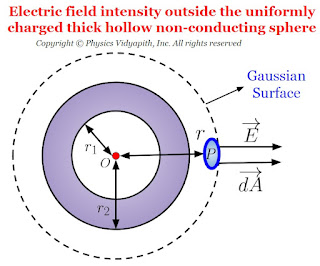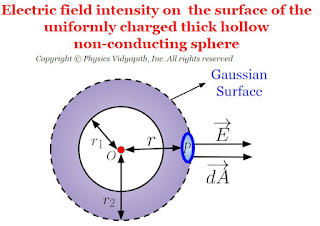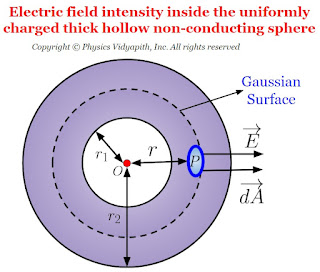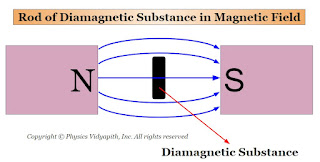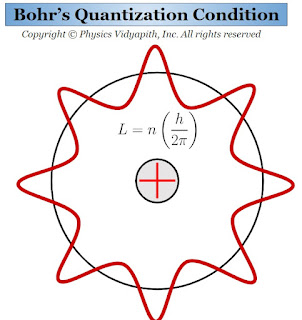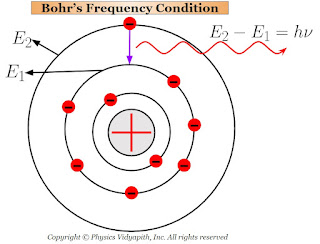A hydrogen-like atom consists of a very small positively-charged nucleus and an electron revolving in a stable circular orbit around the nucleus.
The radius of electrons in stationary orbits:
Let the charge, mass, velocity of the electron and the radius of the orbit is respectively $e$, $m$, and $v$ and $r$. The $+ze$ is the positive charge on the nucleus where $Z$ is the atomic number of the atom. As We know that when an electron revolves around the nucleus then the centripetal force on an electron is provided by the electrostatic force of attraction between the nucleus and an electron, we have
$\frac{mv^{2}}{r}=\frac{1}{4 \pi \epsilon_{\circ}} \frac{(Ze)(e)}{r^{2}}$
$mv^{2}=\frac{Ze^{2}}{4 \pi \epsilon_{\circ} r} \qquad(1)$
According to the first postulate of Bohr's model of the atom, the angular momentum of the electron is
$mvr=n \frac{h}{2 \pi} \qquad(2)$
Where $n \: (=1,2,3,.....)$ is quantum number.
Now squaring equation $(2)$ and dividing by equation $(1)$, we get
$r=n^{2} \frac{h^{2} \epsilon_{\circ}}{\pi m Z e^{2}} \qquad(3)$
The above equation is for the radii of the permitted orbits. From the above equation, this concluded that
$r \propto n^{2}$
Since, $n =1,2,3,.....$ it follows that the radii of the permitted orbits increased in the ratio $1:4:9:16:,.....$ from the first orbit.
Bohr's Radius:
For Hydrogen Atom $(z=1)$, The radius of the atom of the first orbit $(n=1)$ will be
$r_{1}= \frac{h^{2} \epsilon_{\circ}}{\pi m e^{2}}$
This is called Bohr's radius and its value is $0.53 A^{\circ}$. Since $r \propto n^{2}$, the radius of the second orbit of the hydrogen atom will be $( 4 \times 0.53 A^{\circ}) $ and that of the third orbit $9 \times 0.53 A^{\circ}$
The velocity of electrons in stationary orbits:
The velocity of the electron in permitted orbits can be obtained by the formula of equation $(2)$
$v=n\frac{h}{2 \pi m r}$
Now put the value of $r$ in above eqaution from equation $(3)$, we get
$v=\frac{Ze^{2}}{2 h \epsilon_{\circ}} \left( \frac{1}{n} \right) \quad(4)$
Thus $v \propto \frac{1}{n}$
This shows that the velocity of the electron is maximum in the lowest orbit $n=1$ and as goes on higher orbits velocity decreases.
For Hydrogen Atom $(z=1)$, The velocity of electron to move in the first orbit $(n=1)$ is
$v_{1}=\frac{e^{2}}{2h\epsilon_{\circ}}$
Its value is $2.19 \times 10^{6} m/sec$
Note:
$\frac{v_{1}}{c}= \frac{2.19 \times 10^{6}}{3 \times 10^{8}} =\frac{1}{137}$
Thus, $\frac{v_{1}}{c}$ or $\frac{e^{2}}{2h\epsilon_{\circ}}$ is a pure number. It is called the "Fine Structure Constant" and is denoted by $\alpha$
The energy of electrons in stationary orbits:
The total energy $E$ of a moving electron in an orbit is the sum of kinetic energies and potential energies. The kinetic energy of moving the electron in a stationary orbit is:
$K=\frac{1}{2} m v^{2}$
Now susbtitute the value of $v$ from equation $(1)$, we get
$K=\frac{ze^{2}}{8 \pi \epsilon_{\circ} r}$
The potential energy of a moving electron in an orbit of radius $r$ due to the electrostatic attraction between nucleus and electron is given by
$U=\frac{1}{4 \pi \epsilon_{\circ}} \frac{(Ze)(-e)}{r}$
$U=-\frac{Ze^{2}}{4 \pi \epsilon_{\circ} r} $
The total energy of the electron is
$E=K+U$
$E=\frac{ze^{2}}{8 \pi \epsilon_{\circ} r} -\frac{Ze^{2}}{4 \pi \epsilon_{\circ} r} $
$E=-\frac{ze^{2}}{8 \pi \epsilon_{\circ} r}$
Subtituting the value of $r$ in above equation from equation $(3)$, we get
$E=-\frac{mz^{2}e^{4}}{8 \epsilon^{2}_{\circ} h^{2}} \left( \frac{1}{n^{2}} \right) \qquad(5)$
This is the equation for the energy of the electron in the $n^{th}$ orbit.
Suppose, Excited state energy is $E_{2}$ and lower state energy is $E_{1}$. So the energy difference between these two states is:
$E_{2}- E_{1}= \frac{mz^{2}e^{4}}{8 \epsilon^{2}_{\circ} h^{2}} \left( \frac{1}{n_{1}^{2}} -\frac{1}{n_{2}^{2}} \right) \qquad(6)$
According to the third postulate of Bohr's Atomic model, the frequency $\nu$ of the emitted electromagnetic wave:
$\nu=\frac{E_{2}- E_{1}}{h}$
$\nu=\frac{mz^{2}e^{4}}{8 \epsilon^{2}_{\circ} h^{3}} \left( \frac{1}{n_{1}^{2}} -\frac{1}{n_{2}^{2}}\right)$
The corresponding wavelength $\lambda$ of the emitted electromagnetic radiation is given by
$\frac{c}{\lambda}=\frac{mz^{2}e^{4}}{8 \epsilon^{2}_{\circ} h^{3}} \left( \frac{1}{n_{1}^{2}} -\frac{1}{n_{2}^{2}}\right)$
$\frac{1}{\lambda}=\frac{mz^{2}e^{4}}{8 \epsilon^{2}_{\circ} c h^{3}} \left( \frac{1}{n_{1}^{2}} -\frac{1}{n_{2}^{2}}\right) \qquad(7)$
Where $\frac{1}{\lambda}$ is called "wave number" (i.e. number of waves per unit length). In the last equation$(7)$, the quantity $\frac{m e^{4}}{8 \epsilon^{2}_{\circ} c h^{3}}$ is a constant an it is known as "Rydberg Constant (R)". That is
$R = \frac{me^{4}}{8 \epsilon^{2}_{\circ} c h^{3}} \qquad(8)$
So equation $(7)$ can be written as
$\frac{1}{\lambda}=z^{2} R \left( \frac{1}{n_{1}^{2}} -\frac{1}{n_{2}^{2}}\right) \qquad(9)$
This is Bohr's formula for hydrogen and hydrogen-like atoms $(He^{+}, Li^{++},.......)$.
For hydrogen $Z=1$
$\frac{1}{\lambda}= R \left( \frac{1}{n_{1}^{2}} -\frac{1}{n_{2}^{2}}\right) \qquad(10)$
The value of the Rydberg Constant is
$R = \frac{me^{4}}{8 \epsilon^{2}_{\circ} c h^{3}} = 1.090 \times 10^{7} m^{-1}$
This value fairly agrees with empirical value $(1.097 \times 10^{7} m^{-1})$ obtained experimentally by Balmer.
The total energy in terms of Rydberg's Constant:
The $E$ expression can be written in terms of Rydberg's constant $R$ in a simplified form. So from equation $(5)$ and $(8)$ we get
$E=-Z^{2}\frac{Rhc}{n^{2}} \qquad(11)$
Putting the known values of $R$, $h$ and $c$ taking $1 eV =1.6 \times 10^{-19} \: J$ then we get
$E=-Z^{2}\frac{13.6}{n^{2}} \: eV \qquad(12)$
For a Hydrogen atom, $Z=1$
$E=-\frac{13.6}{n^{2}} \: eV \qquad(12)$
